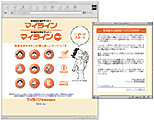Maligned Myline
Back to Contents of Issue: July 2001
|
|
|||
|
by Kyoko Fujimoto |
|||
Until 1985, domestic phone service was completely dominated by NTT. There were no other carriers, like Japan Telecom or KDDI (the original KDD dominated international phone services at that time, but didn't offer domestic). When new carriers did come in, users had to dial a special prefix (00xx) to access the carrier they wanted (otherwise, they'd get connected to NTT by default). With Myline, users can pre-register for the carrier they want to use and pick different carriers in four different categories (local, different city but within the same prefecture, different prefecture, and international), and there will be no need to dial the prefix. This will not only ease the dialing process, but also, supposedly, weaken the NTT monopoly. Users can register or change the carrier for free until the end of October, but will be charged ¥800 for doing so after that. A similar system is widely used in many countries in the West. So far, the service hasn't taken off, for many reasons. One is that registration is accepted through only a hand-written application form -- there's no online or over-the-phone registration -- and the form is in some cases quite complicated: Since most carriers want users to register all categories (for local and for long-distance) under their service, each offers its own form with its own name already printed in the spaces. Users have been griping in Internet chat rooms about their trouble with these forms, saying they had to spend hours arguing to change carriers because they forgot to cross out the carrier name. According to the Myline Carriers Association, there were less than 20 million lines registered with the service as of the end of April, right before kick-off. That's less than a third of the estimated 60 million lines in Japan. What's more, almost 70 percent of the lines registered chose to use ... NTT! A survey by japan.internet.com and Info Plant reveals that some chose NTT because of its TeleHodai service, which lets night-time users call a local number -- usually an ISP -- for a flat rate. Customers can use NTT's TeleHodai service even if they registered with a different carrier, but apparently most don't want to bother changing their computer settings for that.
However, something is happening. In the past few months, many carriers have been trying ridiculously hard to lower their fees by one-tenth of a yen to get more Myline customers. On the marketing front, the competition is furious, featuring ad campaigns by big carriers that sometimes border on nonsensical. Also, a new carrier, Fusion Communications, has joined the fray and is attracting many customers with its low rate. (It offers ¥20/3 minutes, 24 hours a day, to anywhere in Japan using its IP system -- a low rate compared to other big carriers when calling long-distance.) Although they had some system problems in the beginning, Fusion says that as of April 30 it had 360,000 applications -- 1.8 times more than it expected at such an early stage. Fusion is clearly a threat to other carriers -- ad campaigns by big carriers compare rates with other big carriers, but not with Fusion. Then again, the number Fusion announced doesn't necessarily mean that those who applied for the Fusion service have chosen it as their Myline carrier. It offered 10 hours of free calls for the first month to users who registered in April, so many sneaky customers (like this reporter) may have applied just to enjoy the free calls. Many Japanese magazines featured stories on Myline, recommending to readers which line to choose according to their calling habits. But since the frenzied competition keeps the rates and services changing, it seems most publications have given up on following the battle. NTT won't lose its monopoly grip anytime soon, but it's refreshing to see at least some kind of competition going on. |
|||
Note: The function "email this page" is currently not supported for this page.







